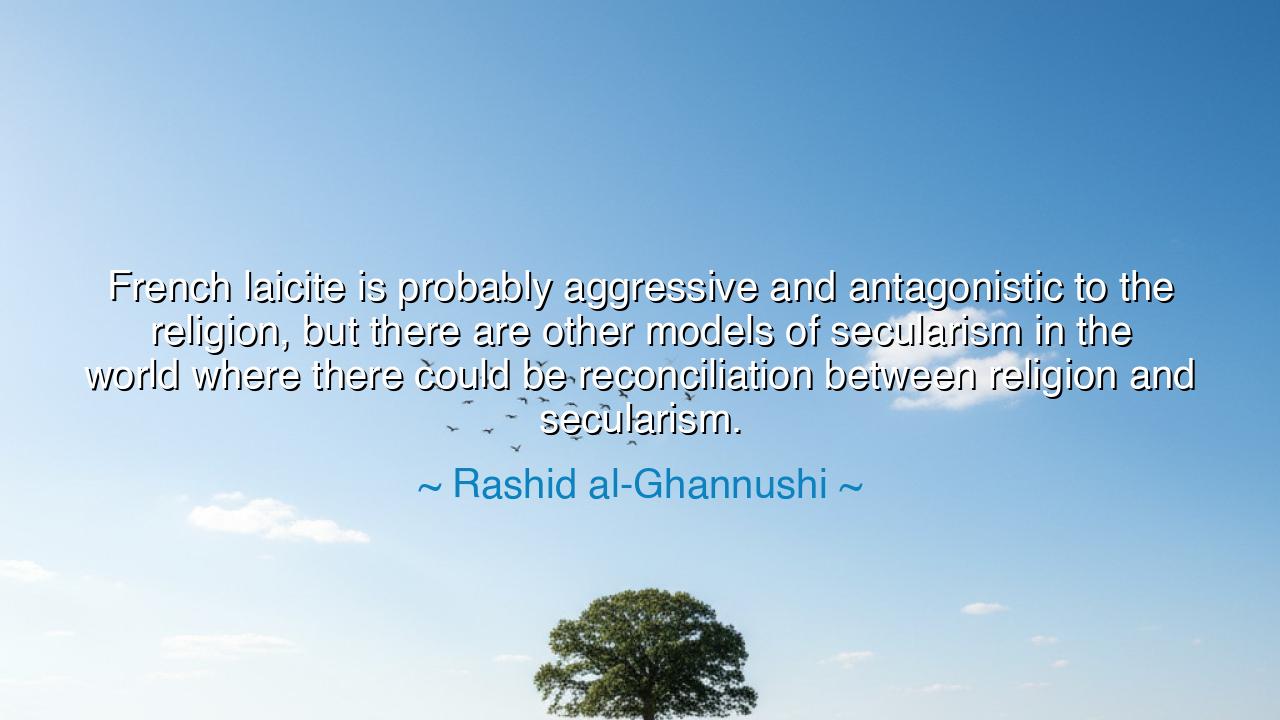
French laicite is probably aggressive and antagonistic to the
French laicite is probably aggressive and antagonistic to the religion, but there are other models of secularism in the world where there could be reconciliation between religion and secularism.






"French laicite is probably aggressive and antagonistic to the religion, but there are other models of secularism in the world where there could be reconciliation between religion and secularism." These words from Rashid al-Ghannushi provide a profound reflection on the relationship between religion and secularism in modern societies. He highlights a tension that has been present throughout history—the struggle between the sacred and the secular, between spiritual freedom and political governance. In his statement, al-Ghannushi critiques the French model of laïcité, which is often perceived as aggressive towards religion, while suggesting that there are other forms of secularism where religion and state can coexist harmoniously.
To understand al-Ghannushi’s insight, we must first examine the origins of laïcité in France. The French Revolution of the late 18th century laid the groundwork for the secularization of French society. It was during this time that church and state were officially separated, and the Catholic Church was stripped of much of its political power. The principle of laïcité was codified in the early 20th century, emphasizing the neutrality of the state in religious matters. This strict separation has often been interpreted as antagonistic to religious expression, as seen in the ban on wearing religious symbols in public schools, or the controversial restrictions on Muslim headscarves and Jewish kippahs in the public sphere. For many, French secularism has become synonymous with the rejection of religious symbols and practices in the public domain.
However, al-Ghannushi’s words invite us to consider that not all secular models are defined by this strict separation. In many cultures, there has been an effort to reconcile the two realms of religion and secular governance, where religion is not necessarily seen as a threat to the state, and the state does not impose its secularism on religious practice. One such example is the model of secularism found in Turkey, where religion and state maintain a delicate balance. Although Turkey has a secular government, its Muslim heritage plays a significant role in the cultural and spiritual life of its citizens. Under the leadership of figures like Mustafa Kemal Atatürk, Turkey sought to create a secular state while also recognizing the role of Islam in shaping the identity of the nation. This model, while imperfect and still evolving, offers a path for reconciliation between religion and secularism that is more inclusive and respectful of religious traditions.
Another historical example is found in India, where the concept of "sarva dharma sambhava" (the equal respect for all religions) has been a cornerstone of the Indian state. India is a nation of profound religious diversity, with Hinduism, Islam, Christianity, and many other faiths coexisting. The Indian model of secularism recognizes that religion is a part of the public sphere, but it ensures that the state treats all religions with equal respect and does not favor one over the others. This inclusive model of secularism allows for religion to be practiced freely in the public sphere while ensuring that the state does not impose any one religious view on its citizens. This is a stark contrast to the more exclusionary forms of secularism that seek to push religion out of the public domain entirely.
In the ancient world, the relationship between religion and state was often intertwined, with kings and emperors being seen as divinely ordained rulers. In ancient Egypt, for example, the pharaoh was not only a political leader but also a god on earth. Similarly, in Mesopotamia, the ruler was often regarded as the representative of the gods, tasked with maintaining order and prosperity. However, as civilizations advanced, the separation between religion and governance became more pronounced. The teachings of Socrates, Plato, and Aristotle in Greece introduced the idea of the polis—a society where reason and logic governed public life, and religious rituals were separate from political governance. These ancient philosophers laid the foundation for what would later become the modern concept of secularism, though their ideas were not without complications in practice.
The lesson of al-Ghannushi’s words is that the relationship between religion and secularism is not fixed; it is something that can evolve in different contexts, depending on the needs and values of a society. A secular state need not be antagonistic to religion; rather, it can create space for religious expression while maintaining neutrality in political matters. The key lies in finding a balance, a reconciliation between these two powerful forces that does not lead to division or exclusion but fosters respect and understanding.
For those of us living in societies where secularism is a dominant force, it is important to reflect on how we can create more inclusive and respectful spaces for religious expression in the public sphere. We must be mindful not to demonize religion in the name of secularism, but rather to encourage dialogue and understanding between these two spheres. Secularism should not be about erasing religion, but about ensuring that the state does not impose its will upon the spiritual lives of its people. By fostering a more inclusive secularism, we create a society that respects both freedom of belief and the role of faith in shaping the lives of individuals. This is a path towards reconciliation, one that acknowledges the complexities of human society and embraces both reason and spirit in shaping the future.






AAdministratorAdministrator
Welcome, honored guests. Please leave a comment, we will respond soon